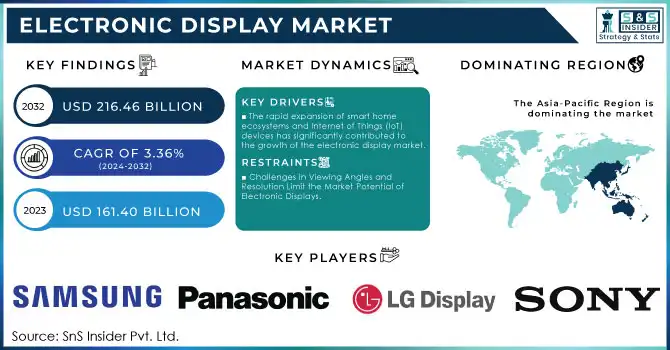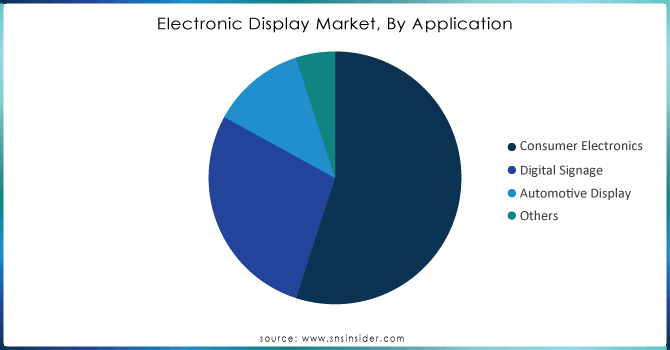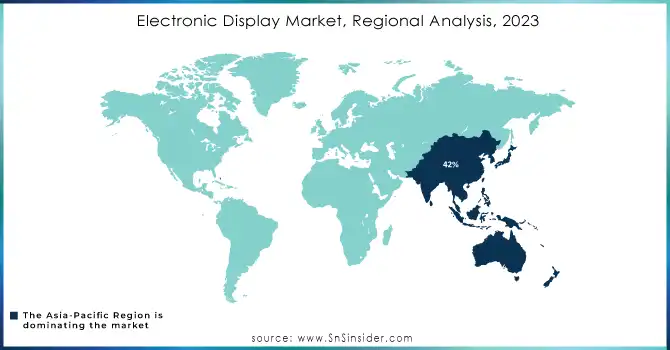Electronic Display Market Size:

Get More Information on Electronic Display Market - Request Sample Report
The Electronic Display Market Size was valued at USD 161.40 Billion in 2023 and is expected to reach USD 216.46 Billion by 2032, growing at a CAGR of 3.36% over the forecast period 2024-2032.
The electronic display market is experiencing significant growth across diverse sectors, from consumer electronics like smartphones, tablets, and TVs to industrial and automotive applications, where they serve as critical tools for communication, monitoring, and control. Devices such as smartphones, smartwatches, and tablets rely on electronic displays to deliver sharp visuals, vibrant colors, and touch-responsive features. As of 2024, the global smartphone landscape is remarkable, with approximately 7.21 billion smartphones in use, accounting for around 90% of the world's 8 billion population. The demographic distribution reveals that China leads in smartphone users, boasting around 1,000 million active users, followed by India with 650 million and the United States with 280 million. Similarly, in 2024, the global smartwatch market boasts approximately 228 million users, with projections indicating this number will grow to 231 million by 2026. The market is set to ship nearly 200 million smartwatches in 2024, reflecting a 16% increase from the previous year, primarily driven by advancements in health and fitness tracking technologies. Manufacturers are continuously investing in developing next-generation displays such as OLEDs, micro-LEDs, and QLEDs to provide enhanced brightness and contrast levels, thus meeting consumers' increasing expectations for quality. Furthermore, the rise of 4K and 8K displays is creating new opportunities in the market, especially in home entertainment systems and gaming monitors, where ultra-high-resolution displays provide immersive viewing experiences.
In the automotive industry, electronic displays have become an integral part of modern vehicle design, significantly contributing to market growth. Displays are utilized in digital instrument clusters, infotainment systems, heads-up displays (HUDs), and rear-seat entertainment systems. These displays enable seamless interaction between the driver and vehicle, offering real-time information such as speed, navigation, and vehicle diagnostics. As electric vehicles (EVs) and autonomous driving technology advance, the demand for high-resolution and adaptable displays in vehicles is expected to rise. The automotive sector's shift toward smart and connected vehicles has made electronic displays an essential component for enhancing user experience and improving safety through advanced display solutions.
Electronic Display Market Dynamics
Drivers
-
The rapid expansion of smart home ecosystems and Internet of Things (IoT) devices has significantly contributed to the growth of the electronic display market.
Displays are a necessary part of smart appliances like refrigerators, washing machines, thermostats, and lighting control systems in smart homes. Around 70 million households in the US are actively using smart home devices in 2024. This is 10.2% more than the 65 million recorded in 2023. With the increasing number of users embracing smart home technologies, there is a rising demand for connected displays that improve user control and interact with other devices. For example, smart speakers such as the Amazon Echo Show or Google Nest Hub, heavily depend on top-notch displays for visual engagement. These screens offer users weather updates, video calls, and interfaces for controlling smart homes. The increasing need for advanced display technologies has resulted from the smooth integration of IoT devices and their interconnected features. Furthermore, IoT integration is becoming more prevalent in sectors such as healthcare and automotive. Modern medical devices, including health monitors and diagnostic equipment, along with infotainment systems in cars, now have state-of-the-art displays. These displays allow for the visualization of data in real time, enhancing functionality and user satisfaction. The increasing use of IoT devices in different industries presents substantial growth opportunities for the electronic display market.
-
The increasing use of AR and VR technologies in gaming, education, healthcare, and retail has led to a growing demand for advanced electronic displays.
High-resolution displays, fast refresh rates, and low latency are necessary for AR and VR to provide immersive experiences. There are approximately 2 billion active AR user devices. Around 3 in 4 adults under the age of 44 are aware of Augmented reality. The use of these technologies in areas like entertainment and training is expanding the limits of display technology. In the world of gaming, VR headsets such as the Oculus Rift and PlayStation VR utilize advanced display technology to offer realistic and immersive gameplay. These screens need to have high resolution and fast refresh rates to reduce motion sickness and improve the realism in the virtual world. In the same way, industries like retail (virtual try-ons), education (interactive learning tools), and healthcare (surgical training) rely on electronic displays that can smoothly superimpose digital information into the physical environment. The progress in AR/VR technologies is still fueling the demand for innovation in display technology, stimulating growth in the electronic display market as businesses pour resources into developing more immersive and captivating experiences.
Restraints
-
Challenges in Viewing Angles and Resolution Limit the Market Potential of Electronic Displays.
Despite improvements in display technology, many electronic displays still have limitations in viewing angles and resolutions. For example, when looked at from a different angle, traditional LCDs may show color distortion and decreased visibility, which can negatively impact the user's experience. Limitations in viewing angles and resolution may discourage consumers from purchasing specific display types, especially for applications that need wide viewing angles, like digital signage and collaborative workspaces. If consumers view a product's performance as unsatisfactory, they might opt for different technologies or brands, hindering market expansion. Addressing these technical hurdles frequently demands a notable financial commitment to research and development, which in turn adds complexity to manufacturing and raises expenses. This investment could put pressure on resources for businesses, especially smaller ones that may not have enough funds to heavily invest in technology development.
Electronic Display Market Segmentation Overview
By Technology
The LCD segment held a major market share of more than 38% in 2023, because of its widespread use in different industries. LCDs are recognized for being cost-effective, energy-efficient, and capable of producing high-quality images, making them ideal for televisions, computer monitors, cell phones, and car displays. Furthermore, the production facilities for LCDs are already in place, resulting in reduced manufacturing expenses when compared to emerging technologies. Samsung and LG heavily rely on LCD technology for their televisions and monitors, whereas Apple has integrated LCDs into a few iPad models.
OLED is to experience the fastest growth rate during the 2024-2032, electronic display market because of its exceptional image quality, flexibility, and lightweight design. OLED screens provide superior contrast ratios, quicker refresh rates, and darker blacks, making them perfect for premium smartphones, televisions, and smartwatches. OLEDs, in contrast to LCDs, do not need a backlight, resulting in thinner screens with more vivid colors. This technology is becoming increasingly popular in the high-end market of electronic screens, as evidenced by Apple's iPhone and Samsung's Galaxy series.
By Application
The consumer electronics segment led the market in the electronic display market with a 55% market share in 2023. The rise in HD and UHD screens has raised consumer standards for better visual experiences. The rise of OLED and AMOLED technologies has increased this expansion due to their superior color accuracy, contrast, and energy efficiency. Samsung and Apple have been leading the way in incorporating advanced displays into their top-of-the-line products, like the Samsung Galaxy series and iPhones, which use OLED screens to provide vibrant and engaging viewing experiences.
The digital signage segment is projected to show the fastest CAGR during 2024-2032, due to the rising need for dynamic advertising, interactive displays, and real-time content delivery across different industries. Retail stores, transport centers, business headquarters, and communal areas utilize digital signage solutions to interact with customers and provide specific information. LG Electronics and NEC play a significant role in offering digital signage solutions to the retail and hospitality industries.

Need Any Customization Research On Electronic Display Market - Inquiry Now
Electronic Display Market Regional Analysis
Asia-Pacific dominated with a 42% market share in 2023, due to its significant production capabilities, efficient manufacturing processes, and a sizable customer population. Nations such as China, Japan, and South Korea are where you can find major display makers like Samsung Electronics, LG Display, and BOE Technology that hold a significant share of the worldwide market. The region's leadership is also reinforced by an increased desire for smartphones, televisions, and gaming monitors, especially in growing markets such as India and Southeast Asia.
North America is anticipated to have the fastest CAGR during 2024-2032, due to the rising popularity of advanced display technologies such as OLED, micro-LED, and quantum dot displays. The region's increasing demand for high-resolution screens in smartphones, tablets, and televisions, along with the growing use of digital signage in industries such as retail and hospitality, continues to drive this growth. Additionally, the participation of major tech companies like Apple, Google, and Microsoft plays a role in the region's progress in display technologies.

Key Players in Electronic Display Market
The major key players in the Electronic Display Market are:
-
Samsung Electronics (QLED TV, OLED Display Panels)
-
LG Display (OLED TVs, Transparent OLED Panels)
-
Sony Corporation (BRAVIA OLED TVs, Crystal LED Display System)
-
BOE Technology Group (Flexible OLED Panels, LCD Panels)
-
Panasonic Corporation (4K UHD TVs, Automotive Display Panels)
-
AU Optronics (AMOLED Displays, TFT-LCD Panels)
-
Sharp Corporation (IGZO Display Panels, AQUOS TVs)
-
TCL Technology (Mini-LED TVs, QLED Displays)
-
Innolux Corporation (LCD TV Panels, Medical Display Panels)
-
Hisense (ULED TVs, Laser Display Technology)
-
Kyocera Corporation (Industrial LCD Displays, Ruggedized Touch Panels)
-
Leyard Optoelectronic (LED Video Walls, MicroLED Displays)
-
ViewSonic Corporation (Projectors, LED Monitors)
-
Barco NV (LED Video Walls, High-Resolution Projectors)
-
Planar Systems (LED Video Walls, Transparent OLED Displays)
-
JDI (Japan Display Inc.) (LTPS LCD Panels, Automotive Display Panels)
-
Acer Inc. (LED Monitors, Gaming Displays)
-
ASUS (Gaming Monitors, OLED Laptops)
-
Vizio Inc. (Smart TVs, Quantum LED TVs)
-
Apple Inc. (Retina Displays, Pro Display XDR)
Suppliers of Raw Materials/Components:
-
Corning Inc.
-
Nitto Denko Corporation
-
3M Company
-
Nichia Corporation
-
Asahi Glass Co., Ltd. (AGC)
-
Sumitomo Chemical Co., Ltd.
-
Merck KGaA
-
DuPont de Nemours, Inc.
-
Saint-Gobain
-
Mitsubishi Chemical Corporation
Recent Development
-
In June 2024, Samsung Electronics announced the global launch of its 2024 Odyssey OLED gaming monitor, Smart Monitor and ViewFinity monitor series. Designed for people and equipped with unexpected features, new and improved models create a new user experience no matter how you use your monitor.
-
In September 2024, MRS Electronics announced the launch of two new displays. This new 4.3-inch and 7-inch display size provides a cost-effective, versatile human-machine interface that fills the gaps between smaller and larger current product offerings that address market demand.
-
In August 2024, Apple Inc., which is looking for new revenue sources, began developing a high-priced home device with a tabletop on which an iPad-like display is located on top of a robotic limb.
| Report Attributes | Details |
|---|---|
| Market Size in 2023 | USD 161.40 Billion |
| Market Size by 2032 | USD 216.46 Billion |
| CAGR | CAGR of 3.36% From 2024 to 2032 |
| Base Year | 2023 |
| Forecast Period | 2024-2032 |
| Historical Data | 2020-2022 |
| Report Scope & Coverage | Market Size, Segments Analysis, Competitive Landscape, Regional Analysis, DROC & SWOT Analysis, Forecast Outlook |
| Key Segments | • By Technology (LCD, LED, OLED, Others) • By Application (Consumer Electronics, Digital Signage, Automotive Display, Others) • By End User (Retail, Entertainment, Corporate, Healthcare, Government) |
| Regional Analysis/Coverage | North America (US, Canada, Mexico), Europe (Eastern Europe [Poland, Romania, Hungary, Turkey, Rest of Eastern Europe] Western Europe [Germany, France, UK, Italy, Spain, Netherlands, Switzerland, Austria, Rest of Western Europe]), Asia Pacific (China, India, Japan, South Korea, Vietnam, Singapore, Australia, Rest of Asia Pacific), Middle East & Africa (Middle East [UAE, Egypt, Saudi Arabia, Qatar, Rest of Middle East], Africa [Nigeria, South Africa, Rest of Africa], Latin America (Brazil, Argentina, Colombia, Rest of Latin America) |
| Company Profiles | Samsung Electronics, LG Display, Sony Corporation, BOE Technology Group, Panasonic Corporation, AU Optronics, Sharp Corporation, TCL Technology, Innolux Corporation, Hisense, Kyocera Corporation, Leyard Optoelectronic, ViewSonic Corporation, Barco NV, Planar Systems, JDI (Japan Display Inc.), Acer Inc., ASUS, Vizio Inc., Apple Inc |
| Key Drivers | • The rapid expansion of smart home ecosystems and Internet of Things (IoT) devices has significantly contributed to the growth of the electronic display market. • The increasing use of AR and VR technologies in gaming, education, healthcare, and retail has led to a growing demand for advanced electronic displays. |
| Restraints | • Challenges in Viewing Angles and Resolution Limit the Market Potential of Electronic Displays. |

